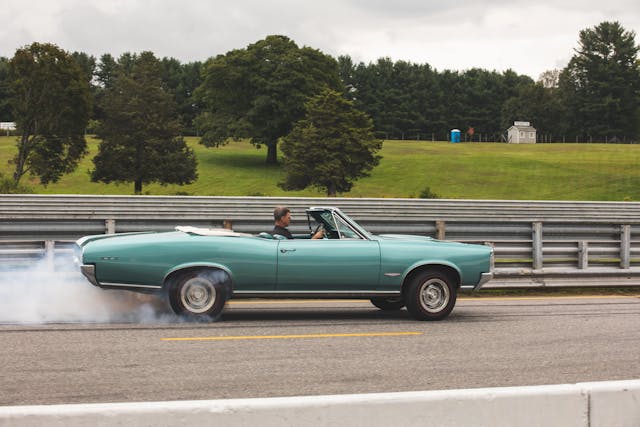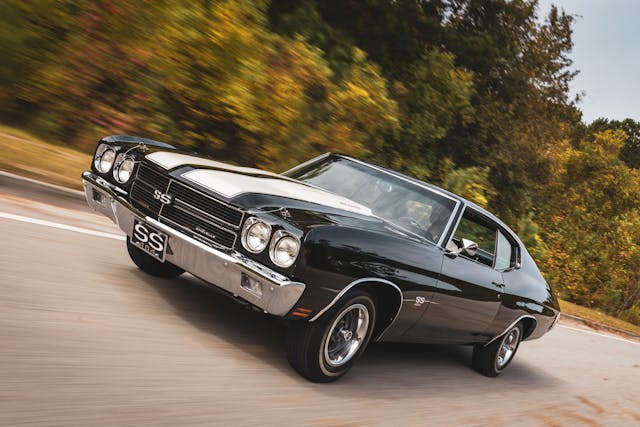Media | Articles
These Popular Classics Are Tracking Straight in a Mixed Market
The last five years have been pretty crazy. There was a pandemic and a whole bunch of other newsworthy items, but even sticking with the classic car market—since that’s what we at Insider know best—things have been topsy-turvy. Aside from some uncertainty in the earlier months of 2020, prices rose at a fast clip for just about everything interesting on four wheels, and kept rising in 2021 and 2022 before slowing down in 2023 and so far in 2024. Many vehicles have even come down in value after their pandemic boom highs, but on average the #2 (“excellent”) value for vehicles in the Hagerty Price Guide is 33% higher than it was five years ago, in the spring of 2019. That outpaces inflation: A hundred dollars five years ago translates to over 120 bucks today.
That doesn’t mean every classic car jumped in value by a third, though. In fact, while quite a few of the market’s most popular classics have been quite active, prices for many others have held steady. The values of these cars have for the most part chugged along at their own pace rather than responding to the whims of the market, or after a brief blip settled back into their prior trajectory. All these examples serve as a reminder that while big numbers can impress when the hammer falls, the meat of the market hasn’t fluctuated as much as some of the top lines would suggest.
Measured by insurance activity, the 1965 Ford Mustang is the most popular classic car in America, and the second most popular is the 1966 Mustang. America’s pony car has indeed had an active five years, with the median condition #2 value up 28 percent over that time. Meanwhile, America’s sports car—the Corvette—has been more stable, at least in its earlier C1 (1953-62) and C2 (1963-67) iterations. The median #2 value for C1s is up 11% over the past five years, and the average up nine percent. For C2s, the median #2 value is up less than one percent, and the average is actually down three percent.
Keeping in the Chevrolet camp, in contrast to the 1967-72 Chevy C/K pickups, which are up an astonishing 72 percent on average over the last five years, muscle car mainstays from the same period have been more understated. The 1968-72 Nova is up just 11 percent, and over the last decade just 13 percent. The median #2 value for 1970 Chevelles is up less than three grand over the last five years. A few other GM muscle staples have been relatively stable as well, with the median #2 value for 1964-67 Pontiac GTOs down three percent and 1968-72 GTOs up 15 percent.



Turning back the clock again to the 1950s American cars, this has generally been a sleepier segment of the market, both before and during the 2020s. A ’50s favorite—the 1957 Chevy Bel Air—has barely moved since 2019. The 1956-57 Lincoln Premiere hasn’t either, while other era-defining cars like the 1957 Chrysler 300C (three percent), 1957-58 Mercury Turnpike Cruiser (two percent), and 1958-60 Edsel (three percent) have also barely nudged.
Even further back, both the Ford Model T and Model A have been mainstays of the old car hobby for longer than almost anything else because they’re so, well, old. The market for them is mature, and they’ve spent the last five years tracking straighter than most other classics. Average #2 values for the 1909-27 Model T are up less than one percent over the last five years. The 1928-31 Model A is up 18 percent, although the median is up 12 percent and many versions haven’t moved at all.


Even with all the movement, both up and down, during this very eventful decade so far, some of our favorite classics have been a lot more consistent. For buyers and sellers of these favorites, it’s always reassuring when a car brings a price that feels right.
***
Check out the Hagerty Media homepage so you don’t miss a single story, or better yet, bookmark it. To get our best stories delivered right to your inbox, subscribe to our newsletters.



The Nova will always be #1 for
Me.
1970 Cuda with Numbers Matching 426/425 HP Hemi Engine, Manual 4-speed Transmission, and Super Track Pack 4:10:1 ratio with Dana 60 axle.
All very interesting comments. Anyone have any guess as to what percentage of classic car hobbyists buy cars simply to collect and store, with no intention to drive them, versus those who want to enjoy them — whether as daily drivers or just on weekends?
One noticeably absent car is always the Chevrolet Impala. I own a restomod 68 SS and rarely have I seen Impala’s mentioned in any story. An occasional bone is thrown to the 69 SS 427, as the last SS, the big block years and the earlier 409 cars. But that is about it. I feel that unless an Impala is built like a Pro Touring car or something similar, it just isn’t getting any love, save for the people that actually own one.
Classic car values follow demographics. The babyboomers bought the cars from their youth driving up prices for cars of that era. Gen X is getting to the age where they have disposable income and will start buying the cars of their youth. If you really want to make some money, sell all those old dinosaurs and buy every chevy Cavalier and Plymouth Neon you can get your hands on. You will be sitting on a goldmine.
Am in my late seventies, and drive a 67 289 Mustang coupe. The great machine has been in the family since my mother bought it in May of ’67. I try to ‘preserve’ and ‘modify’ for safety and performance only. Amazing how many people appreciate and enjoy a “working man’s” (but retired) sporty coupe!
HI MEL, I HAVE A 1966 MUSTANG 298 COUPE 3 SPEED MANUAL THAT I BOUGHT NEW WHEN I WAS 22. I DROVE IT AS A DAILY DRIVER UNTIL THE EARLY 80S. ISTILL ENJOY DRIVING IT WHEN THE WEATHER IS OK. I HAD THE ORIGONAL ENGINE REBUILT AND BODY WORK TO PRESERVE IT LIKE YOURS. THANKS FOR YOUR STORY ! JOHN.
My collection, single/short Cat Eye…09 Z51/6MT…68 C10 Long Bed.
What I Really want is a bigger garage with a ift!
Not seeing to many $25K excellent condition 1970 Chevelle’s out there these days. If you find some I’ll take 2 please.
For real. I’m not sure you could find a 307 2-door Malibu in # 3 condition for that price anymore, at least going by what people are asking for them.
I own a 1994 Jag XJS 2+2 convert with 24,000 certified miles. Beside being a beautiful car just to enjoy looking at it*s a pleasure to drive, Unless you are a very serious collector buy them to enjoy them
Mine is supposed to be worth eleven grand. I could care less, I love it and it’s not for sale. Many have asked if I would sell it but I decline. I’m not in it for the money. I drive it on Sundays, never push it hard or race anybody. I ruined lots of cars when I was young by driving them hard and doing stupid things. It takes time to grow up.
My car is worth eleven grand by estimate. I could care less. I love it and it is not for sale. I never drive it hard or push it past the speed limit. Why break something you love? A car that has survived for over 50 years should be treated with respect. I plan on keeping it until I croak.
1970 Datsun 240Z
car guys are not investment bankers. we love the car, not the money.
The car most overlooked is the 67 or 68 Firebird. The Firebird is a magnificent car overshadowed by the early Camaros, which by the way are a dime a dozen. When I bring my 68 Bird to a car show along with a 1985, 308 GTS & 2014, 458 Spider, everyone goes right to the Firebird. The 2 Ferraris get a glance and an occasional “nice car” but the Firebird gets all the accolades and pictures. I can’t get why the Firebird doesn’t get the recognition it deserves. Perhaps people have forgotten about them, as many times I hear people say just that, they forgot the Firebird or haven’t seen one in 50 years.
It seems like the same old-same old cars are highlighted over & over again-